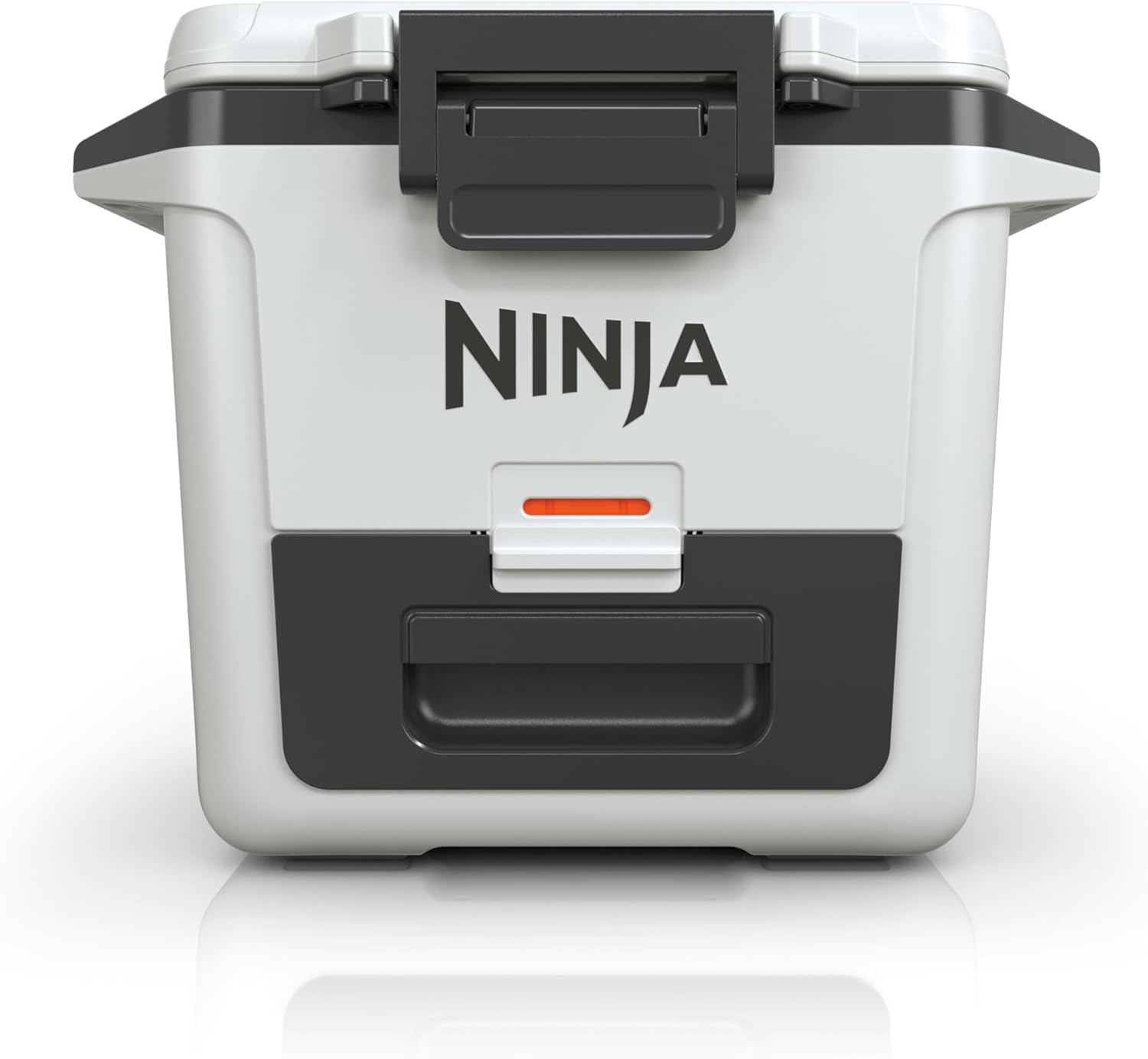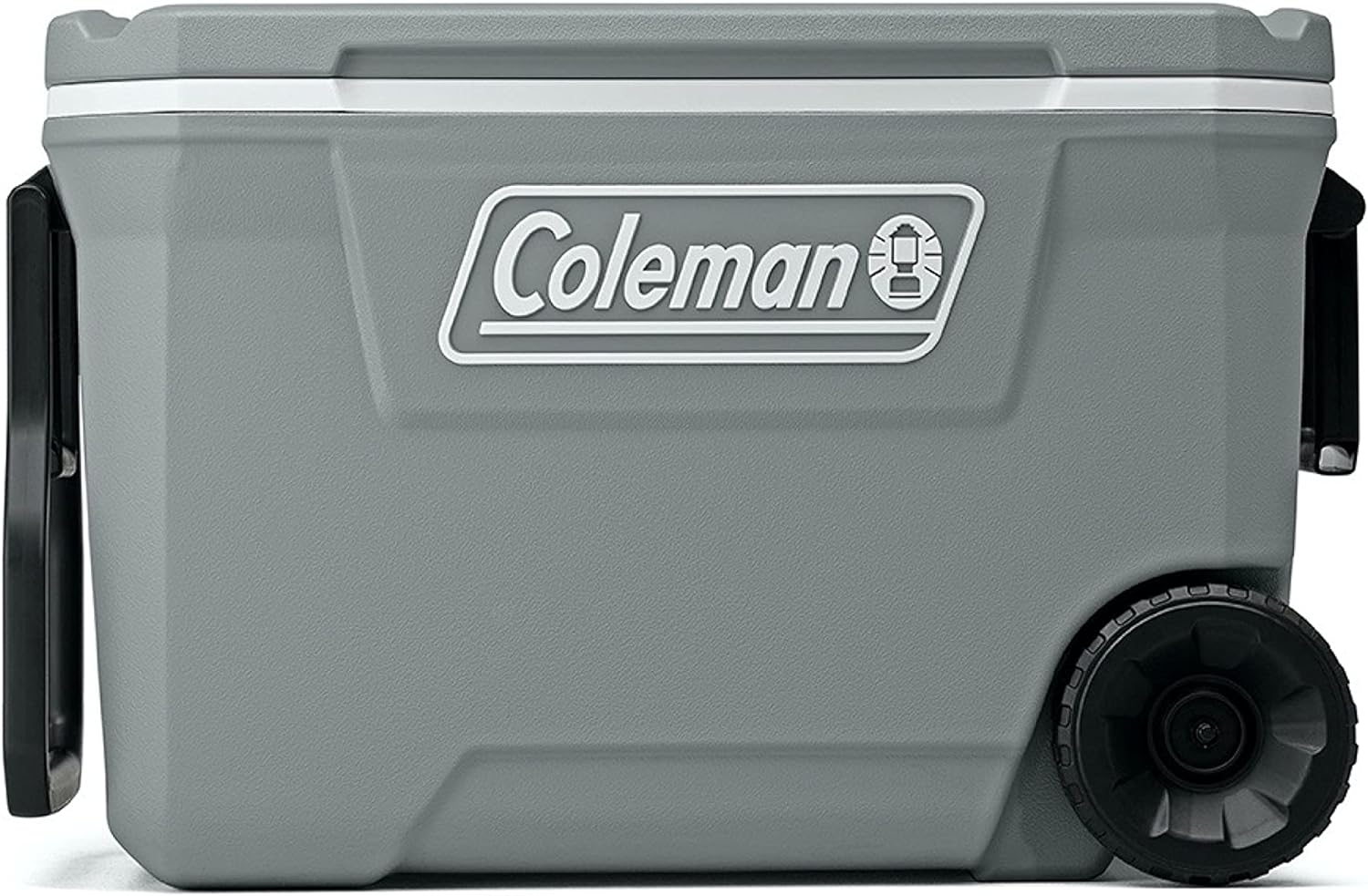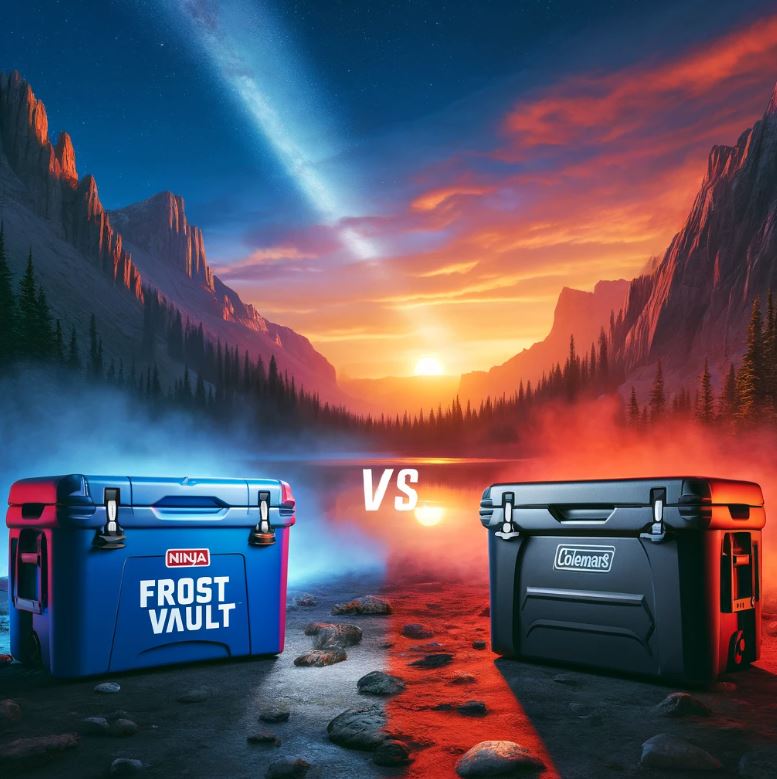I'm a participant in the Amazon Services LLC Associates Program, an affiliate advertising program designed to provide a means for me to earn fees by linking to Amazon.com and affiliated sites.
When it comes to selecting the perfect cooler for your outdoor adventures, two names often rise to the top of the list: Ninja FrostVault and Coleman. Each brand boasts unique features and loyal followings, but how do they truly compare? Let’s dive into a detailed analysis, examining the strengths and nuances of each to help you make an informed decision. Our Ninja FrostVault vs Coleman review is here to show you which cooler is best.
| Feature | Ninja FrostVault Cooler | Coleman Coolers |
|---|---|---|
 |  | |
| Technology | FrostVault Technology | Traditional Insulation |
| Capacity | 50-quart (up to 80 cans) | Varies, from personal to 100-quart models |
| Ice Retention | Up to 6 days | Varies by model, generally up to 5 days |
| Durability | Heavy-duty construction with up to 3 inches of insulation | Durable materials designed for rugged use |
| Ease of Transport | Easy-carry handles and secure latch system | Durable handles, larger models have wheels |
| Price | Generally higher due to advanced features | More affordable, price varies by size and model |
| Innovative Features | Dry Zone for food-safe temperatures, compartmentalized storage | Traditional cooling, reliable performance |
| Security | Lockable lid and drawer latch | Standard latch; some models may have lockable lids |
Key Takeaways – Ninja FrostVault vs Coleman
- Innovative vs. Traditional: The Ninja FrostVault Cooler offers cutting-edge technology with its FrostVault system, providing separate dry and cold zones. Coleman coolers stick to traditional, reliable insulation methods.
- Capacity and Flexibility: While Ninja focuses on a singular, highly innovative model, Coleman offers a wide range of sizes and capacities to suit different needs.
- Durability and Portability: Both brands deliver durable products designed for outdoor adventures. Ninja adds premium features like a secure latch system, while Coleman includes models with wheels for easier transport.
- Price and Value: Ninja’s advanced features come at a higher price point, targeting those who prioritize innovation in their cooler. Coleman provides affordable options without sacrificing quality, aimed at a broader audience.
By considering these factors, outdoor enthusiasts can choose the cooler that best suits their adventure style, budget, and needs, ensuring chilled beverages and fresh food on their next outdoor escapade.
Innovation and Technology
Ninja FrostVault
The Ninja FrostVault Cooler shines with its FrostVault Technology, which ensures cold air is precisely transferred into a Dry Zone, keeping contents cool and dry at food-safe temperatures for days. This innovation stands out for its ability to separate food from ice, preventing soggy sandwiches and waterlogged veggies, a boon for meticulous planners and outdoor gourmets.
Coleman Coolers
Coleman Coolers, on the other hand, are revered for their traditional yet reliable cooling technology. With a focus on insulation and durability, Coleman has mastered the art of ice retention without the frills. Their coolers are straightforward, dependable, and cater to a wide audience, from casual picnickers to serious campers.
Durability and Design – Coleman vs Ninja FrostVault
Ninja FrostVault
The Ninja FrostVault Cooler is designed with rugged adventures in mind. Its heavy-duty construction and up to 3 inches of insulation speak to its ability to withstand the rigors of outdoor use. Additionally, the easy-carry handles and secure latch system are engineered for both convenience and durability, ensuring your cooler stays closed and transportable, no matter where you’re headed.
Coleman Coolers
Coleman Coolers are synonymous with durability. Their products are built to last, using materials that can handle rough handling and extreme temperatures. While they might not boast the same level of innovation in latch design as the Ninja FrostVault, Coleman coolers offer solid, time-tested reliability that has earned them a steadfast position in the market.
Capacity and Usability
Ninja FrostVault
The Ninja FrostVault Cooler’s 50-quart capacity, capable of holding up to 80 cans, is impressive. This, combined with its compartmentalized design, allows for smarter packing and easier access to items without unnecessary digging or rearrangement. The inclusion of a Dry Zone further enhances its usability by offering a dedicated space for items that need to stay dry and cool.
Coleman Coolers
Coleman Coolers are known for their range of sizes and capacities, catering to various needs and group sizes. From personal coolers perfect for a day trip to large, 100-quart options designed for extended family camping, Coleman provides versatility. However, what they offer in variety, they may lack in compartmentalization and the ability to access items without temperature disruption.
Pros and Cons
Ninja FrostVault Cooler
- Pros:
- Innovative FrostVault Technology keeps items cool and dry.
- High capacity with compartmentalized storage.
- Durable construction and easy-carry handles.
- Cons:
- Higher price point due to advanced features.
- Heavier, which might affect portability for some users.
Coleman Coolers
- Pros:
- Wide range of sizes and capacities.
- Time-tested durability and reliability.
- Generally more affordable.
- Cons:
- Lacks advanced compartmentalization and technology.
- Some models may not offer the same ice retention as the Ninja FrostVault.
Major Differences
The key differences between the Ninja FrostVault and Coleman Coolers lie in their approach to technology and design. The Ninja FrostVault Cooler emphasizes innovation with its FrostVault Technology and compartmentalized storage, offering a more sophisticated solution for keeping food and drinks cold. Coleman, while lacking these advanced features, counters with a broad selection of sizes and a reputation for durability and reliability at a more accessible price point.
| Feature | Ninja FrostVault Cooler | Coleman Coolers |
|---|---|---|
 |  | |
| Technology | FrostVault Technology | Traditional Insulation |
| Capacity | 50-quart (up to 80 cans) | Varies, from personal to 100-quart models |
| Ice Retention | Up to 6 days | Varies by model, generally up to 5 days |
| Durability | Heavy-duty construction with up to 3 inches of insulation | Durable materials designed for rugged use |
| Ease of Transport | Easy-carry handles and secure latch system | Durable handles, larger models have wheels |
| Price | Generally higher due to advanced features | More affordable, price varies by size and model |
| Innovative Features | Dry Zone for food-safe temperatures, compartmentalized storage | Traditional cooling, reliable performance |
| Security | Lockable lid and drawer latch | Standard latch; some models may have lockable lids |
Engaging Extras
Exploring the culinary possibilities that these coolers support can add an exciting dimension to your outdoor adventures. Consider incorporating recipes and gadgets that enhance your experience, like how to cook bacon in the oven with aluminum foil, making mushroom chocolates, or even comparing coffee brewing methods with Instant Dual Pod vs Ninja DualBrew and Instant Dual Pod vs Keurig. Enhance your grilling with insights from the Emeril Lagasse French Door Air Fryer Review, blending the thrill of outdoor adventures with the joy of cooking.
For more articles like this, check these out:
- Aroma vs Hamilton Beach (Best Rice Cooker)
- Aroma Rice Cooker vs Instant Pot
- How to Cook Lobster Tail: Mastering Luxurious Lobster
- Best Fast Food Fish Sandwich 2024
- Fast Food Surge Pricing: A New Era in Dining
Detailed Questions and Answers
1. What are the key factors to consider when choosing a cooler for extended camping trips?
When selecting a cooler for extended camping trips, durability is paramount. The cooler must withstand rough handling, changes in weather, and constant use. Materials that resist impacts, secure latches that prevent accidental openings, and robust insulation that keeps contents cold regardless of external temperatures are crucial. A cooler that can endure the rigors of outdoor adventures without failing ensures your food and drinks stay preserved throughout the trip.
Another vital factor is the cooler’s capacity and its ability to maintain temperature. For extended trips, a large capacity is essential to store all necessary food and beverages. However, size should not compromise the cooler’s ice retention capabilities. A cooler that can hold a lot of items but fails to keep them cold is of little use. The ideal cooler balances ample storage space with superior ice retention, ensuring your supplies remain chilled for the duration of your trip.
Lastly, ease of transport plays a significant role in the selection process. Coolers equipped with durable handles, wheels, or straps make moving your supplies less of a chore, especially over uneven terrain or long distances. The weight of the cooler, both empty and full, should also be considered, as it impacts the overall portability. Selecting a cooler that is cumbersome to move can limit your campsite options and overall enjoyment of the trip.
- Durability ensures the cooler can withstand outdoor conditions.
- Capacity and temperature maintenance are crucial for storing sufficient supplies.
- Ease of transport affects the practicality of the cooler for camping.
2. How does ice retention time impact the functionality of a cooler in outdoor settings?
Ice retention time is critical for maintaining food safety and enjoyment in outdoor settings. A cooler with long ice retention time can keep perishable items at safe temperatures, reducing the risk of foodborne illnesses. This is particularly important in remote areas where access to fresh supplies is limited. The ability to store meat, dairy, and other sensitive items safely for extended periods allows for more varied and nutritious meal planning during outdoor adventures.
Furthermore, extended ice retention reduces the need for frequent ice replenishment, which can be inconvenient and sometimes impossible in remote locations. This not only saves time and effort but also helps in minimizing trips to civilization for ice, allowing for a more immersive outdoor experience. The longer your cooler can maintain its temperature, the more you can focus on enjoying your adventure without worrying about preserving your food and drinks.
Lastly, superior ice retention is indicative of a cooler’s overall insulation quality and design efficiency. It reflects the manufacturer’s commitment to providing a product that meets the demands of serious outdoor enthusiasts. A cooler that excels in keeping ice frozen for days on end demonstrates a high level of performance that can be relied upon in various conditions, from scorching summer days to more temperate climates.
- Long ice retention is essential for food safety and variety.
- It minimizes the need for ice replenishment, enhancing convenience.
- Reflects high-quality insulation and design, indicating reliability.
3. In what ways do advanced features like compartmentalization and easy-access lids enhance the outdoor cooler experience?
Advanced features such as compartmentalization and easy-access lids significantly enhance the usability and functionality of coolers in outdoor settings. Compartmentalization allows for better organization of contents, separating items that need to stay dry from those that are okay to be in contact with ice. This not only prevents food from becoming waterlogged but also makes it easier to find what you need without unpacking everything. Such organization can be crucial in maintaining food quality over time and can make meal preparation more efficient and enjoyable.
Easy-access lids, on the other hand, provide convenience by allowing users to quickly grab items without letting all the cold air escape. This feature is particularly beneficial during hot weather, as it minimizes the time the cooler is open, thereby enhancing ice retention. It’s a design innovation that caters to the user’s convenience, reducing the hassle associated with rummaging through a cooler and keeping the internal temperature more stable.
Moreover, these features reflect a thoughtful design that considers the practical aspects of using a cooler in real-world scenarios. They demonstrate an understanding of the challenges and annoyances that outdoor enthusiasts face, offering solutions that make the outdoor dining experience more pleasurable. Ultimately, such advanced features elevate a cooler from a mere storage container to an indispensable tool for outdoor living.
- Compartmentalization improves content organization and food quality.
- Easy-access lids offer convenience and better temperature control.
- Indicate thoughtful design and user-centric innovations.
FAQ Questions with Short Answers
- Why is cooler durability important for camping?
- Durability ensures the cooler can withstand outdoor conditions, protecting your food and drinks.
- Can a cooler be too big for a camping trip?
- Yes, if it’s cumbersome to transport or stores more than you need, affecting portability and ice retention.
- How do I clean my cooler after a trip?
- Wash it with soap and water, and leave it open to dry completely to prevent mold.
- Are there coolers designed specifically for fishing?
- Yes, some coolers come with features like rod holders and scale tops for fishing enthusiasts.
- Can I use dry ice in my cooler?
- Yes, but ensure your cooler is designed to handle dry ice safely to avoid damage.
- How important is the cooler’s color in terms of performance?
- Lighter colors reflect sunlight and may improve ice retention, while darker colors might absorb heat.
- Do all coolers come with a warranty?
- Not all, but many reputable brands offer warranties; check before purchasing.
- Can I replace parts on my cooler, like latches or handles?
- Yes, many brands offer replacement parts for their coolers.
- Is it worth investing in a high-end cooler?
- For serious outdoor enthusiasts who need reliability and extended ice retention, yes.
- How can I maximize ice retention in my cooler?
- Pre-chill your cooler and items, use ice blocks instead of cubes, and open it as infrequently as possible.
